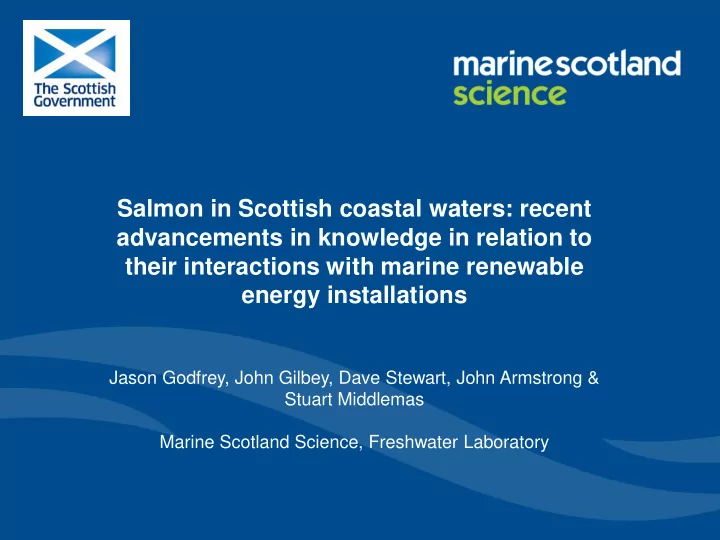

Salmon in Scottish coastal waters: recent advancements in knowledge in relation to their interactions with marine renewable energy installations Jason Godfrey, John Gilbey, Dave Stewart, John Armstrong & Stuart Middlemas Marine Scotland Science, Freshwater Laboratory
• Scottish Government has set targets for the Background development of marine renewable energy • Sustainably? Legal obligations - EU Habitats Directive • Requirement for information about possible interaction between animals, including migratory fish, and MRE developments • Atlantic salmon- economic & conservation value • Starting point is information about spatial overlap between MRE development and fish distributions/routes
Salmon life cycle
Inshore migration of returning adults • Adults return throughout the year – Highest numbers in summer, but valuable stocks in e.g. spring • Information through physical tagging – Known capture and recapture points • Overall picture is complex – Salmon return to coast – Travel to river of origin – No consistent patterns of movement • Limitations of approach – Only have start and end points – Constrained by location of recapture points
Pop up satellite tags MSS Marine Renewable Research MSS Marine Renewable Research • Cannot transmit under water • Record and store depth data during deployment • Programmed to detach (pop up) from fish after defined period • Transmit location and upload data via ARGOS satellite network • Two week battery life after pop- up
Study site -Armadale MSS Marine Renewable Research MSS Marine Renewable Research
Fish capture and tagging MSS Marine Renewable Research • All tagging on board boat MSS Marine Renewable Research • 3 minute procedure • 2 hour recovery period • 1-10 day deployments • Tissue sample taken for identification of region of origin
Release of tagged salmon
Pop-up locations MSS Marine Renewable Research MSS Marine Renewable Research • Are the salmon in a relevant area? • 44/50 tags reported back a location • Mainly coastal, but up to 100km of shore • Daily travel rates up to 55 km/day • Destination? Pop-up locations with error < 25km
Genetic assignment to region of origin • Genetic assignment uses variations in the DNA base codes to differentiate between regions/rivers • Single Nucleotide Polymorphisms (SNPs) used, where variation occurs at a single genetic base • Characterises regions /rivers based on the frequency of SNP variations • SNPs baseline comprising 147 sites and of 3,787 fish with each fish screened at ~5,000 SNPs • Cluster analysis performed to identify assignment units of regions with similar genetic signatures • Identified SNPs which best differentiate between these regions
Preliminary assignment of tagged fish to the baseline regions • Work in progress: only half of the available data have been analysed • New local and international sites currently being added to baseline • International baseline is limited: results not yet robust for these fish • River level assignments under investigation
Depth Use • Energy generation types – surface, mid-water, deep – Direct strike – Cables and electromagnetic fields • Time at depth profiles – Models of strike risk
Atlantic salmon depth and temperature track - river entry
Endothermic shark predation
Mammal predation
Inter-individual variation in depth use MSS Marine Renewable Research MSS Marine Renewable Research Time at depth (%) Time at depth (%) Time at depth (%) 0 20 40 60 80 5 10 15 20 25 30 35 40 45 50 55 60 65 128096 70 128099 75 80 128076 85 90 95 100 105 110
Conclusions MSS Marine Renewable Research MSS Marine Renewable Research • Salmon may migrate at varying distances from the coast • They predominantly inhabit the upper 5m but – Individuals vary (populations?) – All individuals undertake dives – Max dive depths imply that salmon use the entire water column • Individuals from various populations may be present in zones of MRE development • Salmon are most likely to interact with surface devices, but could come into contact with any device.
Next steps MSS Marine Renewable Research MSS Marine Renewable Research • Tag further salmon in summer 2014 using longer tag deployments • Completion of genetics work to identify origins of fish travelling through this area
Recommend
More recommend